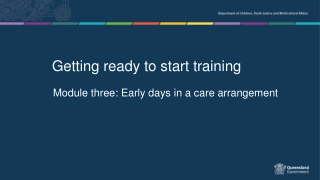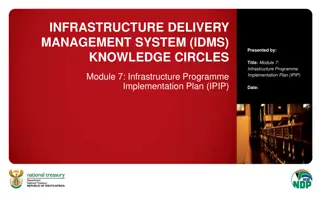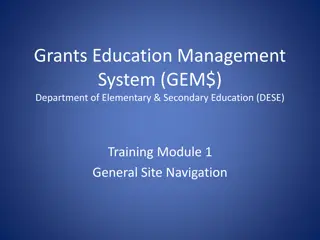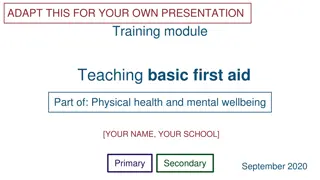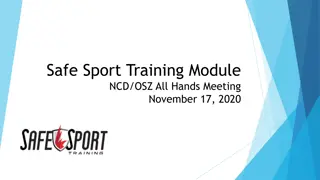
Enhancing Understanding of Dementia Care and Needs
Explore the evolving needs of individuals with dementia and the importance of partnerships in improving their care and quality of life. Learn about different types and stages of dementia, including Alzheimer's disease, Vascular Dementia, Lewy Body Dementia, Frontotemporal Dementia, and more. Gain insights on recognizing early, middle, and late stages of dementia and tailored approaches to support individuals at each stage.
Download Presentation

Please find below an Image/Link to download the presentation.
The content on the website is provided AS IS for your information and personal use only. It may not be sold, licensed, or shared on other websites without obtaining consent from the author. If you encounter any issues during the download, it is possible that the publisher has removed the file from their server.
You are allowed to download the files provided on this website for personal or commercial use, subject to the condition that they are used lawfully. All files are the property of their respective owners.
The content on the website is provided AS IS for your information and personal use only. It may not be sold, licensed, or shared on other websites without obtaining consent from the author.
E N D
Presentation Transcript
Understanding Changing Needs of Persons with Dementia Partnerships to Improve Care and Quality of Life for Persons with Dementia
Goals of Training Goals for series Enhance family involvement in the daily care of loved ones with dementia Promote person-centered care Goals for today Review types and stages of dementia Discuss the Need-Driven Behavior model Use a 1-minute assessment to respond to challenging behaviors
Types of Dementia Dementia: general term for a decline in mental ability that interferes with daily life; many different types Alzheimer s disease: the most common form of dementia Memory loss/problems are key symptom Steady, gradual decline in abilities over time
Types of Dementia Vascular Dementia (VD) Early: Impaired judgement; problems planning, making decisions, organizing Blood vessel damage in brain, strokes Step-wise loss for some; gradual for others Lewy Body Dementia (LBD) Early: Fluctuating confusion, alertness Movement: tremor, stiffness, slowness, walking Visual hallucinations; sleep disturbance
Types of Dementia Frontal Temporal Dementia (FTD) Early: Significant personality & behavior changes Impaired judgment, self-care, insight, language Most stressful type Many other types Brain injury, HIV Substance/medication-induced Parkinson s, Huntington s Mixed/Multiple causes Tailor approaches to individual needs!
Stages of Dementia Consider the stage of disease Early Middle Late
Early Stage Trouble remembering names, losing or misplacing objects, difficulty planning or organizing. Blames stress, fatigue Compensates with lists, memory aids Depression common Note! Memory loss is not the first problem in all types!
Middle Stage Disorientation to time, place, person, things Problems in daily function become apparent Bathing, grooming, dressing, mobility, toileting Language; problems communicating needs Behavioral/psychological symptoms more common Frustration, anger, cursing, name-calling Resistance to care, wandering, difficulty eating
Late Stage Little ability to respond to environment, carry on conversation, or control movement Engages in little purposeful activity Complications are common: choking, falling, others Extensive assistance with daily activities and personal care is needed
Challenging Behaviors Stable individual factors Dementia type, stage of disease Longstanding personality, habits, traits Physical function, disabilities Fluctuating environmental factors Personal needs: physical, social, emotional Physical environment: noise, confusion
Need-Driven Dementia-Compromised Behavior Model Individual factors [Stable] Environmental factors [Fluctuating] Cognitive function Physical function Longstanding personality Habits, traits Physical needs Psychological needs Social environment Physical environment Behavioral & Psychological Symptoms
Need-Driven Model Behavior is communication of unmet needs Start by describing the behavior Who, what, when, where, how long/often? Who is affected by the problem behavior? What triggers can be changed to prevent the behavior? What responses or reactions comfort the person/reduce the behavior?
What does the behavior tell you? Take a 1-minute assessment Wandering? Calling out? Grabbing? Pushing? Agitated? Withdrawn? Intrusiveness? Many possibilities! Boredom? Loneliness? Fear of pain? Desire for privacy? Over-stimulation? Under-stimulation? Hunger, thirst?
Use the Need-Driven Model! 1-minute assessment: Your approach Be aware of communication Is it too long? Too much? Too fast? Too complicated? Are your expectations realistic? Focus on the person vs. the task Use preferred routine, preferences Consider personality Explain what you are doing Be aware of personal space, sense of privacy
Use the Need-Driven Model 1-minute assessment: Adjust next steps Misinterpretation?Use the person s reaction; change course to reassure & calm Reoccurring? Brainstorm possible causes and interventions Look for patterns and document habits Rule out medical or physical problems Re-evaluate frequently
Discussion Breakout Imagine you are leading an activity when one resident becomes upset-crying and yelling for others to get away from her. What might be possible triggers and how would you best approach/provide support?
Summary Type and stage of dementia matters in care Progressive decline means ever-changing abilities! Constantly monitor expectations & approaches Stable & fluctuating factors interact to cause challenging behaviors Assess the person and situation View situations from the person s perspective Adjust your approach to care Work to prevent problems
Coming up next Role Changes for Family Members Explore the role changes and stressors family caregivers face Consider how those changes impact relationships with providers Discuss approaches to ease tensions and build positive relationships with family caregivers


